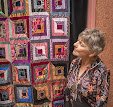The Greystoke Coverlet - a curious textile survival
Recently an interesting-looking coverlet came up for auction at Penrith in Cumbria. The expected price range was given as between £200 and £450. Photographs in the catalogue showed it to be closely covered
in appliqué figures and a great deal of embroidered lettering. The most striking feature was a folded-down panel on which was commemorated Wellington’s victory at the Battle of Vittoria (sic. But it should be 'Vitoria!), 1813. (These panels, often commemorating significant events, were manufactured specifically for use in quilts and other textiles and were widely available. An identical panel is illustrated in two of Averil Colby’s books, Patchwork and Patchwork Quilts, in colour in the latter.) Under the panel, which had been left loose so that it could be lifted, the applique and embroidery are much brighter and in better condition than the rest of the coverlet. It shows a strange scene in which angel’s heads with wings appear above figures showing two couples, apparently flying, as they have wings attached. The men are in what may be military uniforms. On the left is a woman carrying what could be a single rose or a small bouquet followed by a row of three women with arms raised as if towards the flying couples.
Elsewhere on the coverlet other figures have embroidered captions, one of which reads Mary Queen of Scotland, although it was difficult to relate the accompanying illustration to any historical episodes concerning her. This may well be because the fabric in the figures is in many cases worn away almost completely so it’s impossible to decipher what was there originally.
At the bottom of the textile, some female figures have words embroidered under them, for example, ‘Patient woman’ and ‘Hypocrite!’ The embroidered lettering has in places also almost vanished, although it might be possible to read the words using a magnifying glass. The over-all impression somewhat suggests a page of cartoons,with quotes and comments. The embroidered lettering and the appliqué look quite crude and as if done in haste.
Altogether, this is a most intriguing and puzzling textile survival. I learned that it had come from Bushy House in Greystoke, the contents of which were being sold after the death of Adele le Bourgeois Aspel, the widow of a member of the Howard family. The Howards are a long-established Greystoke family whose seat is Greystoke Castle. It seems that many of the items to be auctioned had been found in barns and outbuildings and it could well be that the coverlet had suffered the same fate. Certainly, it is very dirty and clearly hadn’t been stored with a view to its preservation.
I went to view the textile the day before the auction and found it suitably protected by barriers and notices warning of its fragile condition. The Quilters’ Guild of the British Isle would have considered bidding for it but for the fact that the local Museum and Art Gallery, Tullie House in Carlisle, was also interested in it. In such situations, a protocol is observed between museums which means that the local museum has precedence and other museums won’t bid against them. Also, the coverlet was in need of extensive conservation work which would have been very expensive.
Of course, everyone concerned was hoping that Tullie House would win the bidding – they had set a maximum bid higher than the amount the Guild would have gone to. In that case, we would at least have known where it was, that it was being conserved and stored appropriately and, in future, the Guild might even have been able to borrow it.
But I’m sorry to have to report the dénouement to this story: the coverlet went to a private bidder for the stunning sum of £3,500! We shall probably never see it again.


